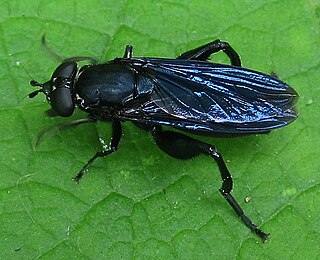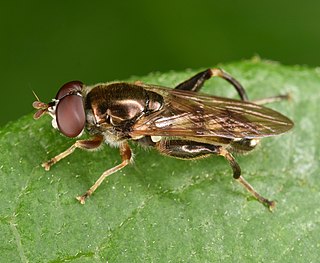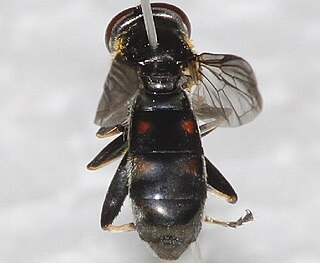
Chalcosyrphus is a genus of hoverflies in the subfamily Eristalinae. Many species exhibit some degree of mimicry of various sawflies and other hymenopterans and are often brightly coloured or metallic in hue. The adults are similar in structure and behavior to the related genus Xylota but differ in larval morphology. They can be found throughout Europe, Asia, and North America and seem to prefer damper, boggy habitats. The larvae are saproxylic feeders in rotten wood in these habitats.

Chalcosyrphus (Xylotomima) inarmatus, the Yellow-haired Leafwalker, is an uncommon species of syrphid fly found across northern North America. Hoverflies are able to remain nearly motionless in flight. The adults are also known as flower flies for they are commonly found around and on flowers, from which they get both energy-giving nectar and protein-rich pollen.

Blera badia, the Common Wood Fly, is a common species of syrphid fly first officially described by Walker in 1849. Hoverflies get their names from the ability to remain nearly motionless while in flight. The adults are also known as flower flies for they are commonly found around and on flowers, from which they get both energy-giving nectar and protein-rich pollen. The larvae are of the rat-tailed type, feeding on exuding sap or in the rot holes of trees.
Temnostoma venustum , the Black-banded Falsehorn , is a rare species of syrphid fly observed in the northeastern United States and adjacent Canada. Hoverflies can remain nearly motionless in flight. The adults are also known as flower flies for they are commonly found on flowers, from which they get both energy-giving nectar and protein rich pollen. Temnostoma adults are strong wasp mimics The larvae burrow in moist decayed wood.
Blera armillata, the orange-faced wood fly, is an uncommon species of syrphid fly first officially described by Osten Sacken in 1875. Hoverflies get their names from the ability to remain nearly motionless while in flight. The adults are also known as flower flies for they are commonly found around and on flowers, from which they get both energy-giving nectar and protein-rich pollen. The larvae are of the rat-tailed type, feeding on exuding sap or in the rot holes of trees.

Chalcosyrphus (Xylotomima) metallicus, the Yellow-legged Leafwalker, is an uncommon species of syrphid fly observed in the southeastern United States. Hoverflies are able to remain nearly motionless while in flight. The adults are also known as flower flies for they are commonly found around and on flowers, from which they get both energy-giving nectar and protein-rich pollen.
Lejota cyanea , the Cobalt Trunksitter, is an uncommon species of syrphid fly observed in the northeast and west coast of North America. Hoverflies can remain nearly motionless in flight. The adults are also known as flower flies for they are commonly found on flowers, from which they get both energy-giving nectar and protein-rich pollen. The larvae of this genus are found in decaying tree roots.
Xylota confusa ,, the Confusing Leafwalker , is an uncommon species of syrphid fly observed across Northern North America. Syrphid flies are also known as Hover Flies or Flower Flies because the adults are frequently found hovering around flowers from which they feed on nectar and pollen. Adults are 9.3–12.6 mm (0.37–0.50 in) long. The larvae of this genus live under bark in sap runs.
Xylota naknek , the Naknek Leafwalker , is a fairly common species of syrphid fly observed across Canada and the Northeastern United States. Syrphid flies are also known as Hover Flies or Flower Flies because the adults are frequently found hovering around flowers from which they feed on nectar and pollen. Adults are 9.1–12.8 mm (0.36–0.50 in) long. The larvae of this genus live under bark in sap runs.
Xylota flavifrons ,, the Northern Leafwalker , is an uncommon species of syrphid fly observed in the northeastern United States and all across Canada. Syrphid flies are also known as Hover Flies or Flower Flies because the adults are frequently found hovering around flowers from which they feed on nectar and pollen. Adults are 9.4–14.7 mm (0.37–0.58 in) long. The larvae of this genus live under bark in sap runs.

Xylota hinei , ( ), the Hine's Leafwalker , is an uncommon species of syrphid fly observed in Eastern Canada. Syrphid flies are also known as Hover Flies or Flower Flies because the adults are frequently found hovering around flowers from which they feed on nectar and pollen. Adults are 7.8–12.9 mm (0.31–0.51 in) long, black with yellow spots. The larvae of this genus live under bark in sap runs.
Heringia canadensis , the Canadian smoothleg, is a fairly common species of syrphid fly observed in many parts of North America. Hoverflies can remain nearly motionless in flight. The adults are also known as flower flies for they are commonly found on flowers from which they get both energy-giving nectar and protein-rich pollen. Larvae when known are aphid predators.
Pipiza macrofemoralis, the large-legged pithead, is a fairly common species of syrphid fly observed in many locations across Northern North America.. Hoverflies can remain nearly motionless in flight. The adults are also known as flower flies for they are commonly found on flowers from which they get both energy-giving nectar and protein-rich pollen. Larvae, when known, are aphid predators.
Hammerschmidtia rufa, the black-bristled logsitter, is an uncommon species of syrphid fly observed across North America. Hoverflies can remain nearly motionless in flight. The adults are also known as flower flies for they are commonly found on flowers from which they get both energy-giving nectar and protein-rich pollen. Larvae have been found under bark of aspen, elm, walnut, and willow. Described as Hammerschmidtia ferruginea by Curran.
Microdon ocellaris, the hairy-legged ant fly, is a rare species of syrphid fly observed in the eastern United States. Hoverflies can remain nearly motionless in flight. The adults are also known as flower flies for they are commonly found on flowers, from which they get both energy-giving nectar and protein-rich pollen. The larvae have been found in the nests of Formica schaufussi.
Microdon ruficrus, the spiny-shield ant fly, is an uncommon species of syrphid fly observed in the eastern United States and adjacent Canada. Hoverflies can remain nearly motionless in flight. The adults are also known as flower flies for they are commonly found on flowers from which they get both energy-giving nectar and protein-rich pollen. Larvae have been found from the nests of Lasius alienus.
Heringia rita, the black-faced spikeleg, is a common species of syrphid fly observed in many locations across North America. Hoverflies can remain nearly motionless in flight. The adults are also known as flower flies for they are commonly found on flowers, from which they get both energy-giving nectar and protein-rich pollen. Larvae have been reared from Adelges piceae and Eriosoma lanigerium.
Heringia elongata, the elongate spikeleg, is an uncommon species of syrphid fly observed in mainly eastern North America but scattered across the US Canadian border to the Pacific Coast. Hoverflies can remain nearly motionless in flight. The adults are also known as flower flies for they are commonly found on flowers, from which they get both energy-giving nectar and protein-rich pollen. Larvae are predators of Eriosoma lanigerum.

Eurimyia stipata, the long-nosed swamp fly, is a very common species of syrphid fly observed across northern North America. Syrphid flies are also known as Hover Flies or Flower Flies because the adults are frequently found hovering around flowers from which they feed on nectar and pollen. Adults are 11.7–17.1 mm (0.46–0.67 in) long with a striped scutum and sawtooth yellow abdominal spots. Larvae of this genus are aquatic.
Trichopsomyia banksi , the white-faced psyllid killer, is an uncommon species of syrphid fly observed across North America. Hoverflies can remain nearly motionless in flight. The adults are also known as flower flies for they are commonly found on flowers from which they get both energy-giving nectar and protein-rich pollen. Larvae are unknown but other members of this genus are psyllid, aphid and Phylloxera predators.





